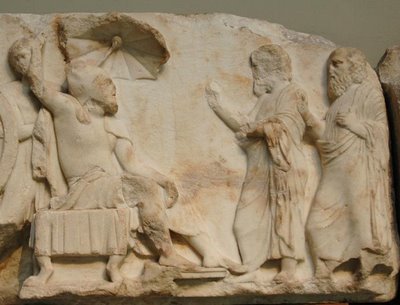An excellent coming-of-age tale in war-torn Iran

A satrap receiving a visitor.
Iranian graphic novelist, M. Satrapi, presents her recent works at MIT
A native of Tehran and a resident of Paris, M. Satrapi is the author and illustrator of the internationally acclaimed graphic autobiographies "Persepolis" (2004) and "Persepolis 2" (2005). She also created a graphic novel,"Embroideries" (2006).
At MIT, Satrapi will discuss her newest work, "Chicken With Plums." The book tells the story of her great-uncle, a celebrated Iranian musician who gave up his life for music and love.
I read Persepolis tonight.
I mean the whole thing. I started it after dinner, and just finished it at the 153rd page. For those of you who've read, or should I say "experienced" this work, that won't come as a surprise. For those of you who haven't, consider it a high-endorsement. My husband and I had other plans...
I also had my doubts about this work. Despite the rave reviews, I've never even read a comic book. That, coupled with the fact that at first glance, it seemed very...well, childish?
Oh the shame! Marjane Satrapi has created an apologetic convert out of me.
Persepolis is the story of one girls experience during the fall of the Shah of Iran, the ensuing Islamic Revolution (which included Stalin like "purges"), and war with Iraq. Only it's not told in plain text, but rather is a pictured in a comic book style. Note: All illustrations in this book are done by her.
A history buff myself, I have an above-average awareness of the historical goings on of that period. However, told in this unorthodox style, with pictures, through the creative and emotional eyes of a child, the "facts" gained a vibrance and color for me like never before. The human side of history had so much more meaning, and seemed to imprint a deeper and easier understanding in my mind than most accounts.
When I was thinking about what was so compelling about this book, I thought of Edward Tufte. He's a famous professor and scientist in the field of displaying information graphically. I went to a seminar by him once. He passionately explained the concept of neural bandwidth, and how most text and plain graphs don't take advantage of the massive processing power of our minds. The pictures in Persepolis, coupled with Marjane's rich historical account seemed to take advantage of that latent neural ability. For me, they compounded and achieved something of an emotional critical mass of understanding that few books have.
So, like I said, I'm a convert. I just ordered her second work "The Story of a Return". Only this time, I'll have a nice bottle of wine, and no plans for the night.
Persepolis: The Story of a Childhood (Paperback)
by Marjane Satrapi "This is me when I was 10 years old..."
 ABF, for the promotion of human rights and democracy in Iran
ABF, for the promotion of human rights and democracy in Iran



1 comment:
Great book.
Post a Comment